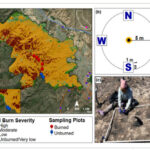レム睡眠のモデルにより、心的外傷後ストレス障害を持つ人々の感情的な恐怖の記憶を抑制する睡眠中の脳の働きを止めるものが明らかになりました。 Models of REM sleep are revealing what stops the sleeping brain from inhibiting emotionally charged fear memories in people experiencing post-traumatic stress disorder.
2023-02-07 バージニア工科大学(VirginiaTech)
◆ビジャヤンは、『Journal of Neuroscience』誌に発表した新しい研究で、睡眠中の脳の生物物理学的モデルを作成するチームを率い、PTSD患者の脳がどのように恐怖記憶を効果的に処理し、消滅させるかをより深く、メカニズム的に探った。
レム睡眠中は、通常、神経伝達物質であるノルエピネフリンとセロトニンの濃度が低下する。研究チームは、このモデルを用いて、神経伝達物質レベルの低下と、前頭前野と扁桃体の間で送られるリズムを通じた、恐怖表現細胞を抑制する脳の機能とを関連づけた。そして、睡眠中のPTSD患者の脳に見られる非典型的な神経伝達物質レベルが、こうした脳内リズムの恐怖を鎮める働きをどのように阻害しているのかを探った。
◆PTSDでは、レム睡眠中の神経伝達物質レベルが高いままである。研究チームのモデルは、このような変化した条件下では、健康な人に通常有効な脳内リズムが、恐怖の記憶を抑制できなくなることを示している。その代わり、PTSD患者の脳は、恐怖の記憶を消すために、より高い周波数のリズムを必要としているようだ。研究チームは、このような高い周波数のリズムを解明することが、PTSD患者の睡眠を回復させる治療法につながると考えている。
◆Vijayan氏のチームは、健康な人の脳と考えられる睡眠状態のモデルから始め、ノルエピネフリンとセロトニンのレベルを下げてレム睡眠を表現した。その結果、前頭前野の神経細胞と扁桃体の神経細胞の間でリズミカルな相互作用が起こり、これら2つの領域の結合が強化された。前頭前野から発せられる脳内リズムは、扁桃体の恐怖記憶細胞の活動を効果的に抑制することがわかった。
研究チームはまた、特定の周波数の脳内リズムが、恐怖表現細胞の抑制に特に効果的であることを見出した。人間に典型的なリズムのシータ領域(4~8ヘルツ)の周波数を入力したところ、4ヘルツ前後の低周波シータリズムが最も効果的に前頭葉領域と扁桃体の間の結合を強化することがわかったのである。
◆次に研究チームは、PTSDを経験した人のレム睡眠をモデル化した。PTSDでは、レム睡眠中にノルエピネフリン濃度が高く保たれることが知られている。Vijayanのチームは、それらの状態を模倣し、4~8ヘルツの脳内リズムを導入すると、それらのリズムはもはや恐怖表現細胞を抑制できないことを発見しました。
研究チームは、他の周波数も試してみた。その結果、10ヘルツという高い周波数で、睡眠中の脳のPTSDモデルにおいて、脳内リズムが恐怖を表現する細胞を効果的に抑制できることがわかった。
PTSD患者の恐怖記憶を抑制する脳内リズムの非定型周波数を特定することで、治療法の開発につながるとVijayan研究員は考えている。
◆次のステップは、眠っているPTSD患者の脳リズムの周波数を、彼らにとって適切なリズムになるように調整する方法を検討することである。ビジャヤンが「秘密の聴覚刺激」と呼んでいるものを使えば、それが可能です。
“つまり、私がその音を流しているのに、あなたは眠っている間にそれに気づかないということです “とVijayanは言いました。「PTSDだけでなく、外傷性脳損傷やパーキンソン病など、睡眠が妨げられるあらゆる種類の障害に役立つ可能性があります。望ましい神経ダイナミクスを誘導することで、睡眠の回復力を発揮させることができるということです。
<関連情報>
- https://vtx.vt.edu/articles/2023/01/science-sujith_vijayan_neroscience_ptsd_rem_sleep.html
- https://www.jneurosci.org/content/43/3/433
レム睡眠時の情動記憶処理と心的外傷後ストレス障害への影響 Emotional Memory Processing during REM Sleep with Implications for Post-Traumatic Stress Disorder
Young-Ah Rho, Jason Sherfey and Sujith Vijayan
Journal of Neuroscience Published:8 January 2023
DOI: https://doi.org/10.1523/JNEUROSCI.1020-22.2022
Abstract
REM sleep is important for the processing of emotional memories, including fear memories. Rhythmic interactions, especially in the theta band, between the medial prefrontal cortex (mPFC) and limbic structures are thought to play an important role, but the ways in which memory processing occurs at a mechanistic and circuits level are largely unknown. To investigate how rhythmic interactions lead to fear extinction during REM sleep, we used a biophysically based model that included the infralimbic cortex (IL), a part of the mPFC with a critical role in suppressing fear memories. Theta frequency (4–12 Hz) inputs to a given cell assembly in IL, representing an emotional memory, resulted in the strengthening of connections from the IL to the amygdala and the weakening of connections from the amygdala to the IL, resulting in the suppression of the activity of fear expression cells for the associated memory. Lower frequency (4 Hz) theta inputs effected these changes over a wider range of input strengths. In contrast, inputs at other frequencies were ineffective at causing these synaptic changes and did not suppress fear memories. Under post-traumatic stress disorder (PTSD) REM sleep conditions, rhythmic activity dissipated, and 4 Hz theta inputs to IL were ineffective, but higher-frequency (10 Hz) theta inputs to IL induced changes similar to those seen with 4 Hz inputs under normal REM sleep conditions, resulting in the suppression of fear expression cells. These results suggest why PTSD patients may repeatedly experience the same emotionally charged dreams and suggest potential neuromodulatory therapies for the amelioration of PTSD symptoms.
SIGNIFICANCE STATEMENT Rhythmic interactions in the theta band between the mPFC and limbic structures are thought to play an important role in processing emotional memories, including fear memories, during REM sleep. The infralimbic cortex (IL) in the mPFC is thought to play a critical role in suppressing fear memories. We show that theta inputs to the IL, unlike other frequency inputs, are effective in producing synaptic changes that suppress the activity of fear expression cells associated with a given memory. Under PTSD REM sleep conditions, lower-frequency (4 Hz) theta inputs to the IL do not suppress the activity of fear expression cells associated with the given memory but, surprisingly, 10 Hz inputs do. These results suggest potential neuromodulatory therapies for PTSD.



